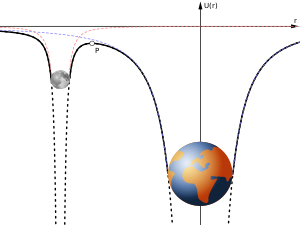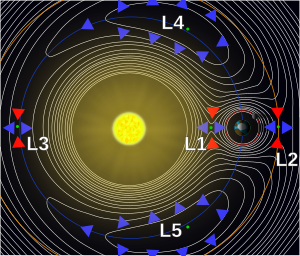 Global Information
Global InformationHill sphere information
This article has multiple issues. Please help improve it or discuss these issues on the talk page. (Learn how and when to remove these template messages)
|

| Part of a series on |
| Astrodynamics |
|---|
|
Orbital mechanics |
|
Celestial mechanics |
|
Engineering and efficiency |
The Hill sphere is a common model for the calculation of a gravitational sphere of influence. It is the most commonly used model to calculate the spatial extent of gravitational influence of an astronomical body (m) in which it dominates over the gravitational influence of other bodies, particularly a primary (M).[1] It is sometimes confused with other models of gravitational influence, such as the Laplace sphere[1] or being called the Roche sphere, the latter causing confusion with the Roche limit.[2][3] It was defined by the American astronomer George William Hill, based on the work of the French astronomer Édouard Roche.[not verified in body]
To be retained by a more gravitationally attracting astrophysical object—a planet by a more massive star, a moon by a more massive planet—the less massive body must have an orbit that lies within the gravitational potential represented by the more massive body's Hill sphere.[not verified in body] That moon would, in turn, have a Hill sphere of its own, and any object within that distance would tend to become a satellite of the moon, rather than of the planet itself.[not verified in body]

One simple view of the extent of the Solar System is that it is bounded by the Hill sphere of the Sun (engendered by the Sun's interaction with the galactic nucleus or other more massive stars).[4][verification needed] A more complex example is the one at right, the Earth's Hill sphere, which extends between the Lagrange points L1 and L2,[clarification needed] which lie along the line of centers of the Earth and the more massive Sun.[not verified in body] The gravitational influence of the less massive body is least in that direction, and so it acts as the limiting factor for the size of the Hill sphere;[clarification needed] beyond that distance, a third object in orbit around the Earth would spend at least part of its orbit outside the Hill sphere, and would be progressively perturbed by the tidal forces of the more massive body, the Sun, eventually ending up orbiting the latter.[not verified in body]
For two massive bodies with gravitational potentials and any given energy of a third object of negligible mass interacting with them, one can define a zero-velocity surface in space which cannot be passed, the contour of the Jacobi integral.[not verified in body] When the object's energy is low, the zero-velocity surface completely surrounds the less massive body (of this restricted three-body system), which means the third object cannot escape; at higher energy, there will be one or more gaps or bottlenecks by which the third object may escape the less massive body and go into orbit around the more massive one.[not verified in body] If the energy is at the border between these two cases, then the third object cannot escape, but the zero-velocity surface confining it touches a larger zero-velocity surface around the less massive body[verification needed] at one of the nearby Lagrange points, forming a cone-like point there.[clarification needed][not verified in body] At the opposite side of the less massive body, the zero-velocity surface gets close to the other Lagrange point.[not verified in body] This limiting zero-velocity surface around the less massive body is its Hill "sphere".[according to whom?][original research?]
- ^ a b Souami, D.; Cresson, J.; Biernacki, C.; Pierret, F. (2020). "On the local and global properties of gravitational spheres of influence". Monthly Notices of the Royal Astronomical Society. 496 (4): 4287–4297. arXiv:2005.13059. doi:10.1093/mnras/staa1520.
- ^ Williams, Matt (2015-12-30). "How Many Moons Does Mercury Have?". Universe Today. Retrieved 2023-11-08.
- ^ Hill, Roderick J. (2022). "Gravitational clearing of natural satellite orbits". Publications of the Astronomical Society of Australia. 39. Cambridge University Press. Bibcode:2022PASA...39....6H. doi:10.1017/pasa.2021.62. ISSN 1323-3580. S2CID 246637375.
- ^ Chebotarev, G. A. (March 1965). "On the Dynamical Limits of the Solar System". Soviet Astronomy. 8: 787. Bibcode:1965SvA.....8..787C.